Strategic Marketing Report: Arcadia Group's Swiss Entry
VerifiedAdded on 2023/01/11
|13
|3659
|26
Report
AI Summary
This report provides a strategic marketing analysis for Arcadia Group, a British multinational company planning to introduce a premium clothing line in Switzerland. The report begins with an executive summary and an introduction outlining the objectives. The main body of the report delves into macro-environmental factors using PESTEL analysis, assessing political, economic, social, technological, environmental, and legal factors impacting the company's operations. It then evaluates suitable market entry modes, with franchising highlighted as the most appropriate strategy. The report also explores market segmentation and targeting concepts, including demographic, geographic, psychographic, and behavioral segmentation. Finally, it applies Porter's generic strategies to determine competitive advantages. The conclusion summarizes the key findings, and references are provided for all sources. This assignment offers insights into strategic marketing principles and their practical application in a real-world business scenario, making it a valuable resource for students seeking to understand market entry and strategic planning.

Strategic Marketing
Paraphrase This Document
Need a fresh take? Get an instant paraphrase of this document with our AI Paraphraser
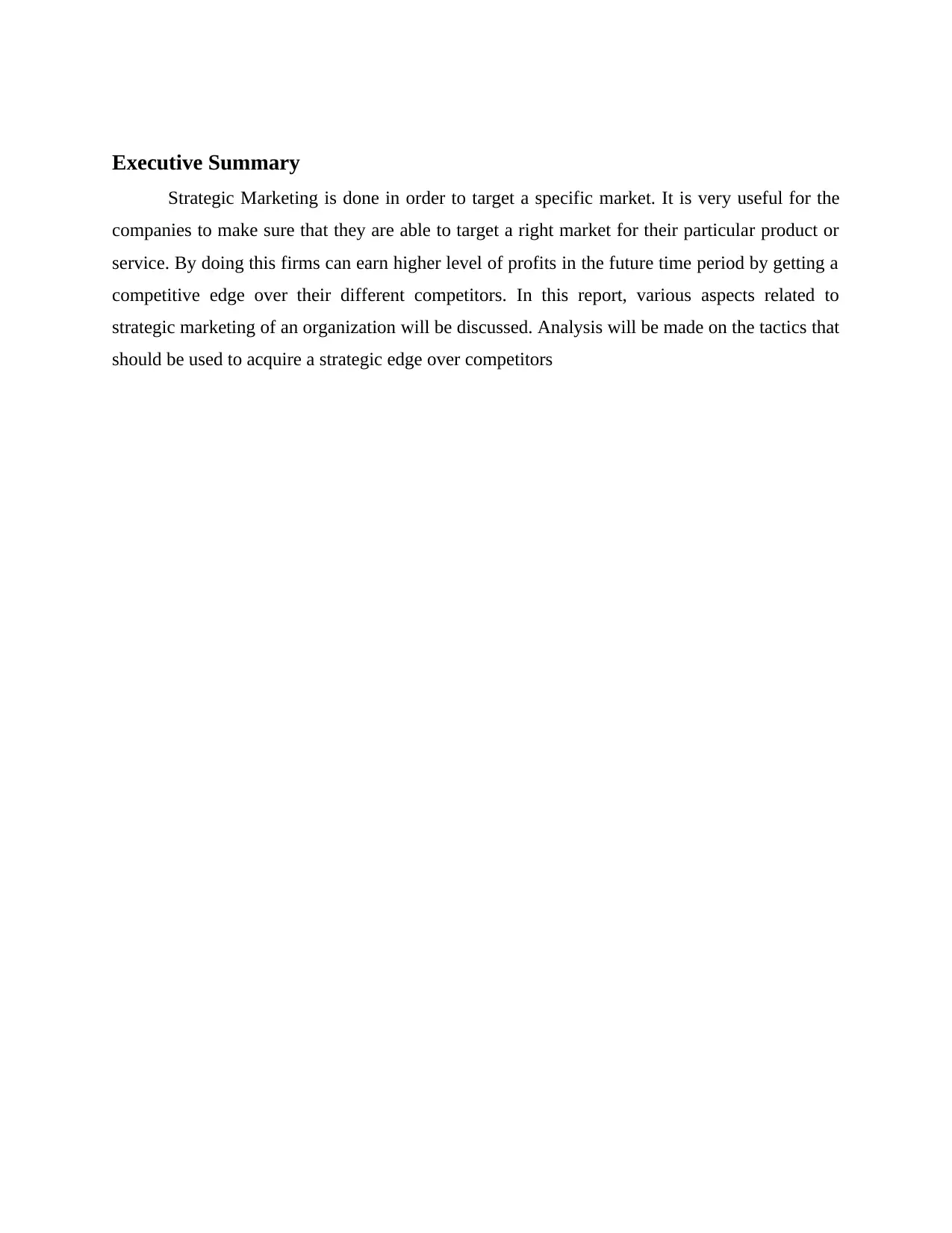
Executive Summary
Strategic Marketing is done in order to target a specific market. It is very useful for the
companies to make sure that they are able to target a right market for their particular product or
service. By doing this firms can earn higher level of profits in the future time period by getting a
competitive edge over their different competitors. In this report, various aspects related to
strategic marketing of an organization will be discussed. Analysis will be made on the tactics that
should be used to acquire a strategic edge over competitors
Strategic Marketing is done in order to target a specific market. It is very useful for the
companies to make sure that they are able to target a right market for their particular product or
service. By doing this firms can earn higher level of profits in the future time period by getting a
competitive edge over their different competitors. In this report, various aspects related to
strategic marketing of an organization will be discussed. Analysis will be made on the tactics that
should be used to acquire a strategic edge over competitors
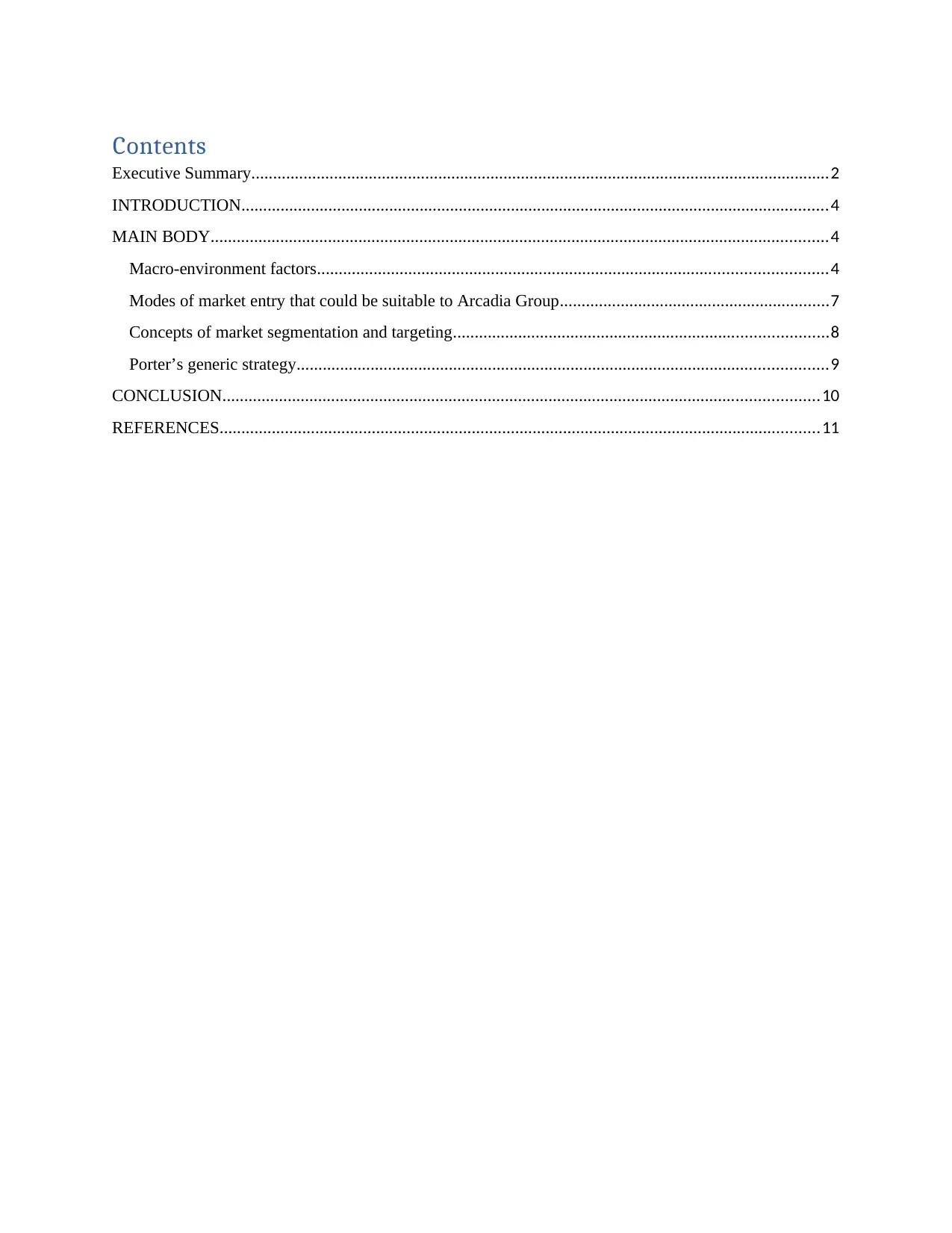
Contents
Executive Summary.....................................................................................................................................2
INTRODUCTION.......................................................................................................................................4
MAIN BODY..............................................................................................................................................4
Macro-environment factors.....................................................................................................................4
Modes of market entry that could be suitable to Arcadia Group..............................................................7
Concepts of market segmentation and targeting......................................................................................8
Porter’s generic strategy..........................................................................................................................9
CONCLUSION.........................................................................................................................................10
REFERENCES..........................................................................................................................................11
Executive Summary.....................................................................................................................................2
INTRODUCTION.......................................................................................................................................4
MAIN BODY..............................................................................................................................................4
Macro-environment factors.....................................................................................................................4
Modes of market entry that could be suitable to Arcadia Group..............................................................7
Concepts of market segmentation and targeting......................................................................................8
Porter’s generic strategy..........................................................................................................................9
CONCLUSION.........................................................................................................................................10
REFERENCES..........................................................................................................................................11
⊘ This is a preview!⊘
Do you want full access?
Subscribe today to unlock all pages.

Trusted by 1+ million students worldwide

INTRODUCTION
Strategic marketing refers to the activities which are undertaken by an organization in its
marketing for getting a competitive edge over its rivals in the future (Hollebeek, Conduit and
Brodie, 2016). Therefore, this can allow the companies to maximize their level of profits easily
by taking an appropriate route. It has to done effectively and efficiently so that a strategic edge
can be acquired without issues and problems. For this report, Arcadia Group has been selected
which is a British multinational company provides different kind of clothing products to its
customers. The organization wants to open a store in Switzerland and wants to introduce a new
premium line of clothes there. In this assignment, specific analysis will be made on macro-
environment factors affecting the firm, models of market entry which the firm can choose.
Additionally, the concept of market segmentation and application of Porter’s Generic Strategies
will be discussed as a part of this project.
MAIN BODY
Macro-environment factors
Macro-environment refers to the external forces which can impact the level of
profitability of an organization (The Macro Environment- Six Forces In The Environment Of A
Business, 2015). The factors related to it can be analyzed using PESTEL analysis. It is explained
in the context of Arcadia Group as follows-
Political factors- These are government policy, political stability and corruption
(Josephson, Johnson and Mariadoss, 2016). In Switzerland, there is a relative political stability
which can allow Arcadia Group to target its customers there and earn profits.
Opportunity- If the government of Switzerland brings a stable policy regarding
businesses then it will positively influence Arcadia Group.
Threat- If there is political instability arising in Switzerland then it will lead to creation
of problems and issues for Arcadia Group.
Solution to threat- By providing the right products to the customers Arcadia Group can
keep itself safe in any political situation.
Strategic marketing refers to the activities which are undertaken by an organization in its
marketing for getting a competitive edge over its rivals in the future (Hollebeek, Conduit and
Brodie, 2016). Therefore, this can allow the companies to maximize their level of profits easily
by taking an appropriate route. It has to done effectively and efficiently so that a strategic edge
can be acquired without issues and problems. For this report, Arcadia Group has been selected
which is a British multinational company provides different kind of clothing products to its
customers. The organization wants to open a store in Switzerland and wants to introduce a new
premium line of clothes there. In this assignment, specific analysis will be made on macro-
environment factors affecting the firm, models of market entry which the firm can choose.
Additionally, the concept of market segmentation and application of Porter’s Generic Strategies
will be discussed as a part of this project.
MAIN BODY
Macro-environment factors
Macro-environment refers to the external forces which can impact the level of
profitability of an organization (The Macro Environment- Six Forces In The Environment Of A
Business, 2015). The factors related to it can be analyzed using PESTEL analysis. It is explained
in the context of Arcadia Group as follows-
Political factors- These are government policy, political stability and corruption
(Josephson, Johnson and Mariadoss, 2016). In Switzerland, there is a relative political stability
which can allow Arcadia Group to target its customers there and earn profits.
Opportunity- If the government of Switzerland brings a stable policy regarding
businesses then it will positively influence Arcadia Group.
Threat- If there is political instability arising in Switzerland then it will lead to creation
of problems and issues for Arcadia Group.
Solution to threat- By providing the right products to the customers Arcadia Group can
keep itself safe in any political situation.
Paraphrase This Document
Need a fresh take? Get an instant paraphrase of this document with our AI Paraphraser

Economic factors- These are economic growth, exchange rates and interest rates.
Switzerland’s GDP growth is among the best in the world which offers various opportunities to
Arcadia Group.
Opportunity- Increasing GDP growth rate of Switzerland offers an excellent opportunity
to Arcadia Group to get its sales to increase in the country.
Threat- An increase in inflation rate can affect the prospects of Arcadia Group in
Switzerland as the customers may not buy its premium clothes (Aghazadeh, 2015).
Solution to threat- By keeping its prices in a fair range Arcadia Group can ensure that it
is able to evade this threat effectively and efficiently.
Social factors- These are population growth rate, age distribution, career attitudes etc. These
factors can impact the business of Arcadia Group in Switzerland as these factors are required to
be considered by it for its marketing.
Opportunity- Change in social customs offer Arcadia Group an opportunity in
Switzerland as it can introduce its premium clothing range there to earn more profits.
Threat- Strict social customs in certain places in Switzerland can impact the business of
Arcadia Group as it will lead towards problems and issues.
Solution to threat- By making sure that the clothes which it wants to introduce in the
country are according to social traditions Arcadia Group can make sure that it can
effectively evade this threat.
Technological factors- These are technology incentives, level of innovation and R&D
activity (Kim, Shin and Min, 2016). These factors can create an impact on Arcadia Group
because it needs to introduce new technology for the purpose of staying on in the market.
Opportunity- By innovating, Arcadia Group can make sure that it obtains a strategic
edge quickly in the market of Switzerland. Therefore by doing this the company can earn
higher level of profits.
Threat- If Arcadia Group is not able to adapt to technology quickly in Switzerland then
it will be in disadvantage as it will result in lower revenues for it.
Solution to threat- The threat related to technology can be resolved by regularly
adapting to new technology as and when it comes in the market.
Switzerland’s GDP growth is among the best in the world which offers various opportunities to
Arcadia Group.
Opportunity- Increasing GDP growth rate of Switzerland offers an excellent opportunity
to Arcadia Group to get its sales to increase in the country.
Threat- An increase in inflation rate can affect the prospects of Arcadia Group in
Switzerland as the customers may not buy its premium clothes (Aghazadeh, 2015).
Solution to threat- By keeping its prices in a fair range Arcadia Group can ensure that it
is able to evade this threat effectively and efficiently.
Social factors- These are population growth rate, age distribution, career attitudes etc. These
factors can impact the business of Arcadia Group in Switzerland as these factors are required to
be considered by it for its marketing.
Opportunity- Change in social customs offer Arcadia Group an opportunity in
Switzerland as it can introduce its premium clothing range there to earn more profits.
Threat- Strict social customs in certain places in Switzerland can impact the business of
Arcadia Group as it will lead towards problems and issues.
Solution to threat- By making sure that the clothes which it wants to introduce in the
country are according to social traditions Arcadia Group can make sure that it can
effectively evade this threat.
Technological factors- These are technology incentives, level of innovation and R&D
activity (Kim, Shin and Min, 2016). These factors can create an impact on Arcadia Group
because it needs to introduce new technology for the purpose of staying on in the market.
Opportunity- By innovating, Arcadia Group can make sure that it obtains a strategic
edge quickly in the market of Switzerland. Therefore by doing this the company can earn
higher level of profits.
Threat- If Arcadia Group is not able to adapt to technology quickly in Switzerland then
it will be in disadvantage as it will result in lower revenues for it.
Solution to threat- The threat related to technology can be resolved by regularly
adapting to new technology as and when it comes in the market.
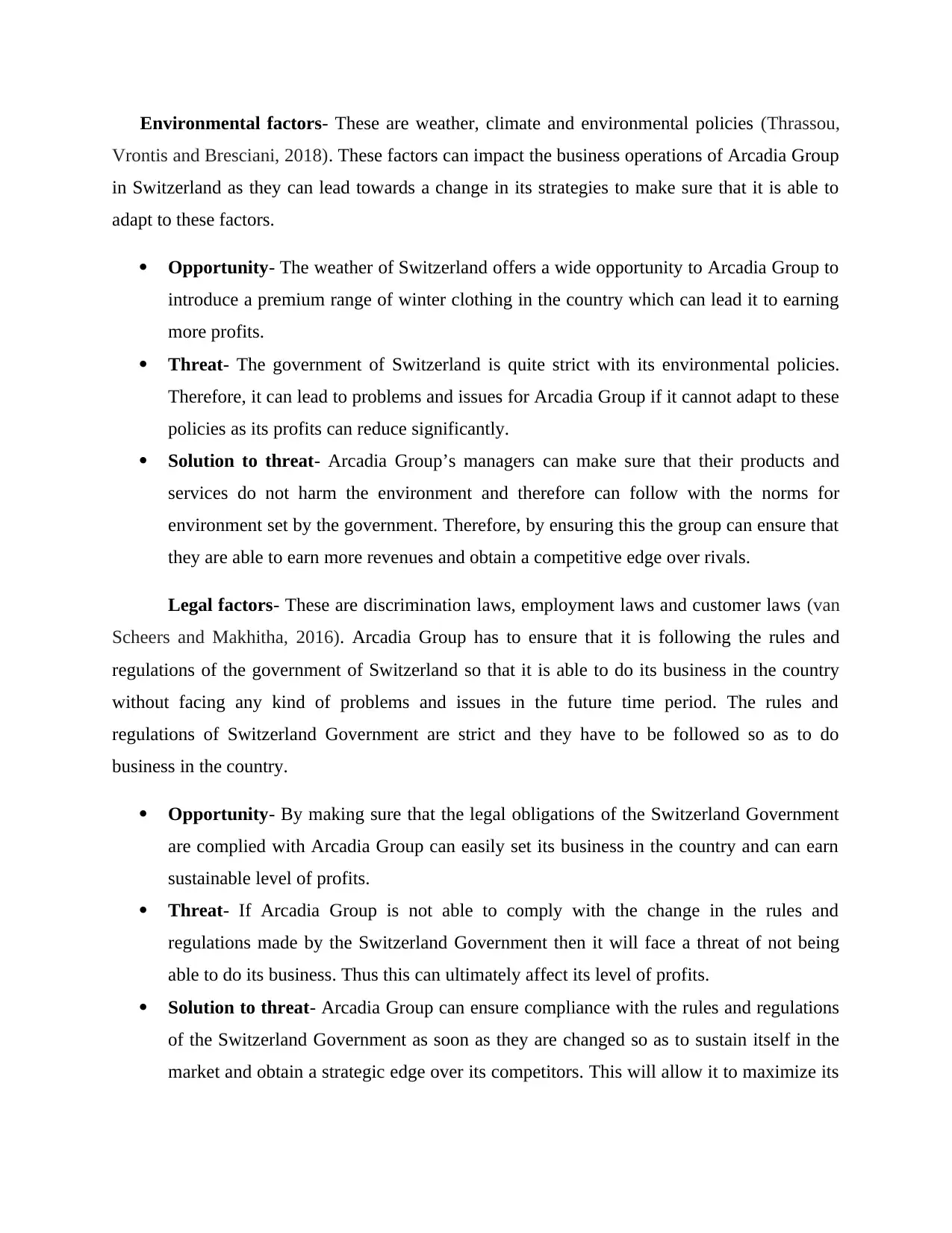
Environmental factors- These are weather, climate and environmental policies (Thrassou,
Vrontis and Bresciani, 2018). These factors can impact the business operations of Arcadia Group
in Switzerland as they can lead towards a change in its strategies to make sure that it is able to
adapt to these factors.
Opportunity- The weather of Switzerland offers a wide opportunity to Arcadia Group to
introduce a premium range of winter clothing in the country which can lead it to earning
more profits.
Threat- The government of Switzerland is quite strict with its environmental policies.
Therefore, it can lead to problems and issues for Arcadia Group if it cannot adapt to these
policies as its profits can reduce significantly.
Solution to threat- Arcadia Group’s managers can make sure that their products and
services do not harm the environment and therefore can follow with the norms for
environment set by the government. Therefore, by ensuring this the group can ensure that
they are able to earn more revenues and obtain a competitive edge over rivals.
Legal factors- These are discrimination laws, employment laws and customer laws (van
Scheers and Makhitha, 2016). Arcadia Group has to ensure that it is following the rules and
regulations of the government of Switzerland so that it is able to do its business in the country
without facing any kind of problems and issues in the future time period. The rules and
regulations of Switzerland Government are strict and they have to be followed so as to do
business in the country.
Opportunity- By making sure that the legal obligations of the Switzerland Government
are complied with Arcadia Group can easily set its business in the country and can earn
sustainable level of profits.
Threat- If Arcadia Group is not able to comply with the change in the rules and
regulations made by the Switzerland Government then it will face a threat of not being
able to do its business. Thus this can ultimately affect its level of profits.
Solution to threat- Arcadia Group can ensure compliance with the rules and regulations
of the Switzerland Government as soon as they are changed so as to sustain itself in the
market and obtain a strategic edge over its competitors. This will allow it to maximize its
Vrontis and Bresciani, 2018). These factors can impact the business operations of Arcadia Group
in Switzerland as they can lead towards a change in its strategies to make sure that it is able to
adapt to these factors.
Opportunity- The weather of Switzerland offers a wide opportunity to Arcadia Group to
introduce a premium range of winter clothing in the country which can lead it to earning
more profits.
Threat- The government of Switzerland is quite strict with its environmental policies.
Therefore, it can lead to problems and issues for Arcadia Group if it cannot adapt to these
policies as its profits can reduce significantly.
Solution to threat- Arcadia Group’s managers can make sure that their products and
services do not harm the environment and therefore can follow with the norms for
environment set by the government. Therefore, by ensuring this the group can ensure that
they are able to earn more revenues and obtain a competitive edge over rivals.
Legal factors- These are discrimination laws, employment laws and customer laws (van
Scheers and Makhitha, 2016). Arcadia Group has to ensure that it is following the rules and
regulations of the government of Switzerland so that it is able to do its business in the country
without facing any kind of problems and issues in the future time period. The rules and
regulations of Switzerland Government are strict and they have to be followed so as to do
business in the country.
Opportunity- By making sure that the legal obligations of the Switzerland Government
are complied with Arcadia Group can easily set its business in the country and can earn
sustainable level of profits.
Threat- If Arcadia Group is not able to comply with the change in the rules and
regulations made by the Switzerland Government then it will face a threat of not being
able to do its business. Thus this can ultimately affect its level of profits.
Solution to threat- Arcadia Group can ensure compliance with the rules and regulations
of the Switzerland Government as soon as they are changed so as to sustain itself in the
market and obtain a strategic edge over its competitors. This will allow it to maximize its
⊘ This is a preview!⊘
Do you want full access?
Subscribe today to unlock all pages.

Trusted by 1+ million students worldwide
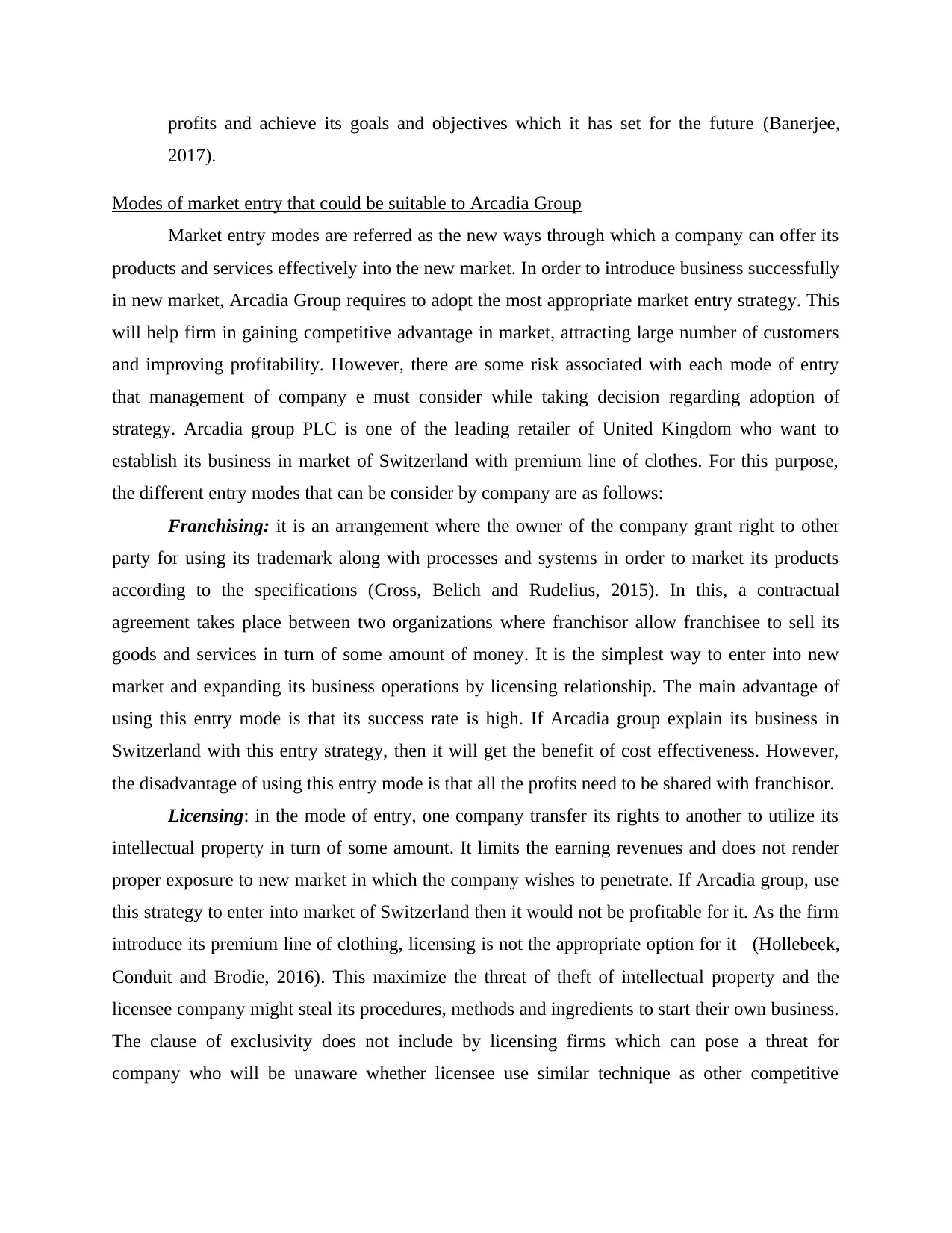
profits and achieve its goals and objectives which it has set for the future (Banerjee,
2017).
Modes of market entry that could be suitable to Arcadia Group
Market entry modes are referred as the new ways through which a company can offer its
products and services effectively into the new market. In order to introduce business successfully
in new market, Arcadia Group requires to adopt the most appropriate market entry strategy. This
will help firm in gaining competitive advantage in market, attracting large number of customers
and improving profitability. However, there are some risk associated with each mode of entry
that management of company e must consider while taking decision regarding adoption of
strategy. Arcadia group PLC is one of the leading retailer of United Kingdom who want to
establish its business in market of Switzerland with premium line of clothes. For this purpose,
the different entry modes that can be consider by company are as follows:
Franchising: it is an arrangement where the owner of the company grant right to other
party for using its trademark along with processes and systems in order to market its products
according to the specifications (Cross, Belich and Rudelius, 2015). In this, a contractual
agreement takes place between two organizations where franchisor allow franchisee to sell its
goods and services in turn of some amount of money. It is the simplest way to enter into new
market and expanding its business operations by licensing relationship. The main advantage of
using this entry mode is that its success rate is high. If Arcadia group explain its business in
Switzerland with this entry strategy, then it will get the benefit of cost effectiveness. However,
the disadvantage of using this entry mode is that all the profits need to be shared with franchisor.
Licensing: in the mode of entry, one company transfer its rights to another to utilize its
intellectual property in turn of some amount. It limits the earning revenues and does not render
proper exposure to new market in which the company wishes to penetrate. If Arcadia group, use
this strategy to enter into market of Switzerland then it would not be profitable for it. As the firm
introduce its premium line of clothing, licensing is not the appropriate option for it (Hollebeek,
Conduit and Brodie, 2016). This maximize the threat of theft of intellectual property and the
licensee company might steal its procedures, methods and ingredients to start their own business.
The clause of exclusivity does not include by licensing firms which can pose a threat for
company who will be unaware whether licensee use similar technique as other competitive
2017).
Modes of market entry that could be suitable to Arcadia Group
Market entry modes are referred as the new ways through which a company can offer its
products and services effectively into the new market. In order to introduce business successfully
in new market, Arcadia Group requires to adopt the most appropriate market entry strategy. This
will help firm in gaining competitive advantage in market, attracting large number of customers
and improving profitability. However, there are some risk associated with each mode of entry
that management of company e must consider while taking decision regarding adoption of
strategy. Arcadia group PLC is one of the leading retailer of United Kingdom who want to
establish its business in market of Switzerland with premium line of clothes. For this purpose,
the different entry modes that can be consider by company are as follows:
Franchising: it is an arrangement where the owner of the company grant right to other
party for using its trademark along with processes and systems in order to market its products
according to the specifications (Cross, Belich and Rudelius, 2015). In this, a contractual
agreement takes place between two organizations where franchisor allow franchisee to sell its
goods and services in turn of some amount of money. It is the simplest way to enter into new
market and expanding its business operations by licensing relationship. The main advantage of
using this entry mode is that its success rate is high. If Arcadia group explain its business in
Switzerland with this entry strategy, then it will get the benefit of cost effectiveness. However,
the disadvantage of using this entry mode is that all the profits need to be shared with franchisor.
Licensing: in the mode of entry, one company transfer its rights to another to utilize its
intellectual property in turn of some amount. It limits the earning revenues and does not render
proper exposure to new market in which the company wishes to penetrate. If Arcadia group, use
this strategy to enter into market of Switzerland then it would not be profitable for it. As the firm
introduce its premium line of clothing, licensing is not the appropriate option for it (Hollebeek,
Conduit and Brodie, 2016). This maximize the threat of theft of intellectual property and the
licensee company might steal its procedures, methods and ingredients to start their own business.
The clause of exclusivity does not include by licensing firms which can pose a threat for
company who will be unaware whether licensee use similar technique as other competitive
Paraphrase This Document
Need a fresh take? Get an instant paraphrase of this document with our AI Paraphraser
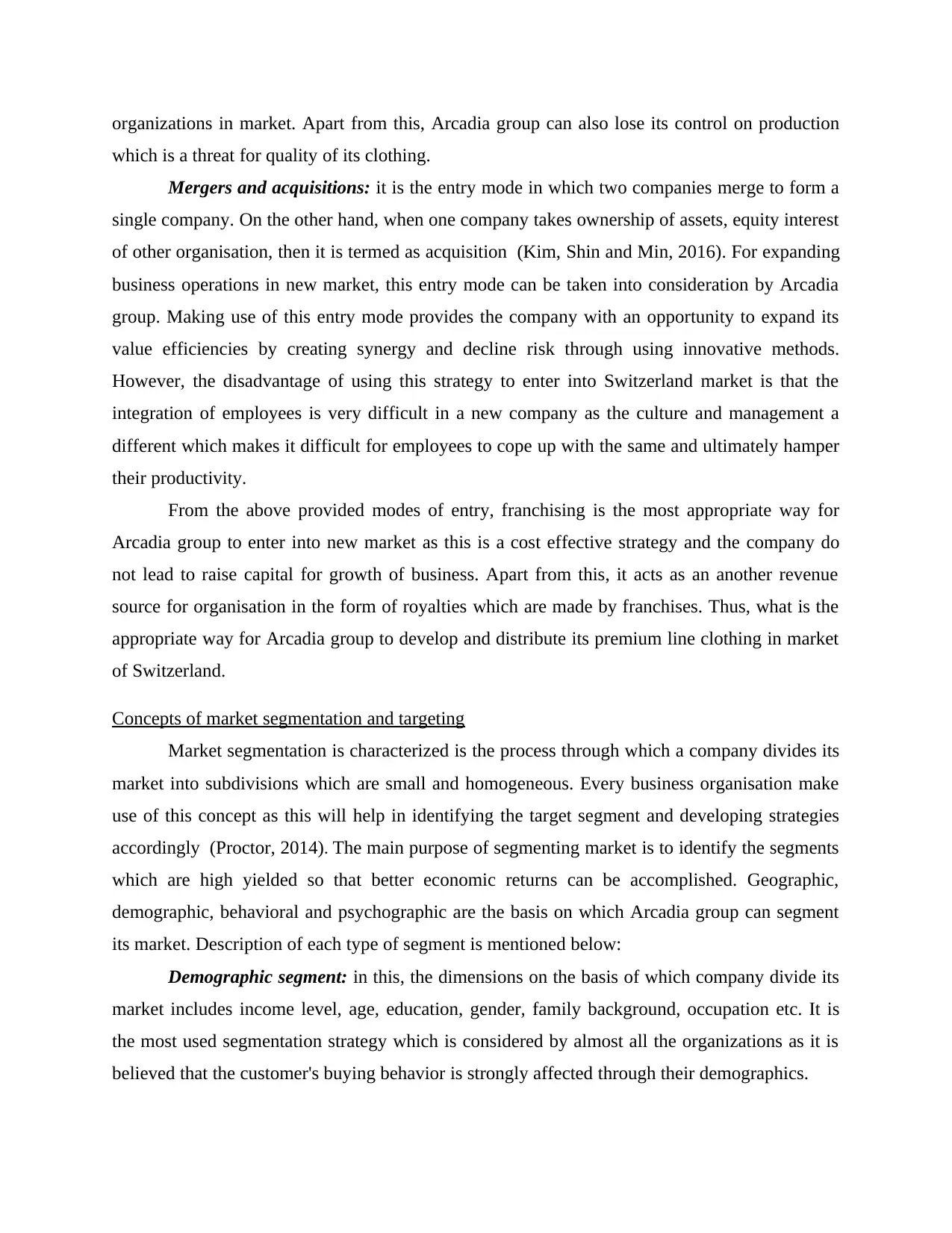
organizations in market. Apart from this, Arcadia group can also lose its control on production
which is a threat for quality of its clothing.
Mergers and acquisitions: it is the entry mode in which two companies merge to form a
single company. On the other hand, when one company takes ownership of assets, equity interest
of other organisation, then it is termed as acquisition (Kim, Shin and Min, 2016). For expanding
business operations in new market, this entry mode can be taken into consideration by Arcadia
group. Making use of this entry mode provides the company with an opportunity to expand its
value efficiencies by creating synergy and decline risk through using innovative methods.
However, the disadvantage of using this strategy to enter into Switzerland market is that the
integration of employees is very difficult in a new company as the culture and management a
different which makes it difficult for employees to cope up with the same and ultimately hamper
their productivity.
From the above provided modes of entry, franchising is the most appropriate way for
Arcadia group to enter into new market as this is a cost effective strategy and the company do
not lead to raise capital for growth of business. Apart from this, it acts as an another revenue
source for organisation in the form of royalties which are made by franchises. Thus, what is the
appropriate way for Arcadia group to develop and distribute its premium line clothing in market
of Switzerland.
Concepts of market segmentation and targeting
Market segmentation is characterized is the process through which a company divides its
market into subdivisions which are small and homogeneous. Every business organisation make
use of this concept as this will help in identifying the target segment and developing strategies
accordingly (Proctor, 2014). The main purpose of segmenting market is to identify the segments
which are high yielded so that better economic returns can be accomplished. Geographic,
demographic, behavioral and psychographic are the basis on which Arcadia group can segment
its market. Description of each type of segment is mentioned below:
Demographic segment: in this, the dimensions on the basis of which company divide its
market includes income level, age, education, gender, family background, occupation etc. It is
the most used segmentation strategy which is considered by almost all the organizations as it is
believed that the customer's buying behavior is strongly affected through their demographics.
which is a threat for quality of its clothing.
Mergers and acquisitions: it is the entry mode in which two companies merge to form a
single company. On the other hand, when one company takes ownership of assets, equity interest
of other organisation, then it is termed as acquisition (Kim, Shin and Min, 2016). For expanding
business operations in new market, this entry mode can be taken into consideration by Arcadia
group. Making use of this entry mode provides the company with an opportunity to expand its
value efficiencies by creating synergy and decline risk through using innovative methods.
However, the disadvantage of using this strategy to enter into Switzerland market is that the
integration of employees is very difficult in a new company as the culture and management a
different which makes it difficult for employees to cope up with the same and ultimately hamper
their productivity.
From the above provided modes of entry, franchising is the most appropriate way for
Arcadia group to enter into new market as this is a cost effective strategy and the company do
not lead to raise capital for growth of business. Apart from this, it acts as an another revenue
source for organisation in the form of royalties which are made by franchises. Thus, what is the
appropriate way for Arcadia group to develop and distribute its premium line clothing in market
of Switzerland.
Concepts of market segmentation and targeting
Market segmentation is characterized is the process through which a company divides its
market into subdivisions which are small and homogeneous. Every business organisation make
use of this concept as this will help in identifying the target segment and developing strategies
accordingly (Proctor, 2014). The main purpose of segmenting market is to identify the segments
which are high yielded so that better economic returns can be accomplished. Geographic,
demographic, behavioral and psychographic are the basis on which Arcadia group can segment
its market. Description of each type of segment is mentioned below:
Demographic segment: in this, the dimensions on the basis of which company divide its
market includes income level, age, education, gender, family background, occupation etc. It is
the most used segmentation strategy which is considered by almost all the organizations as it is
believed that the customer's buying behavior is strongly affected through their demographics.
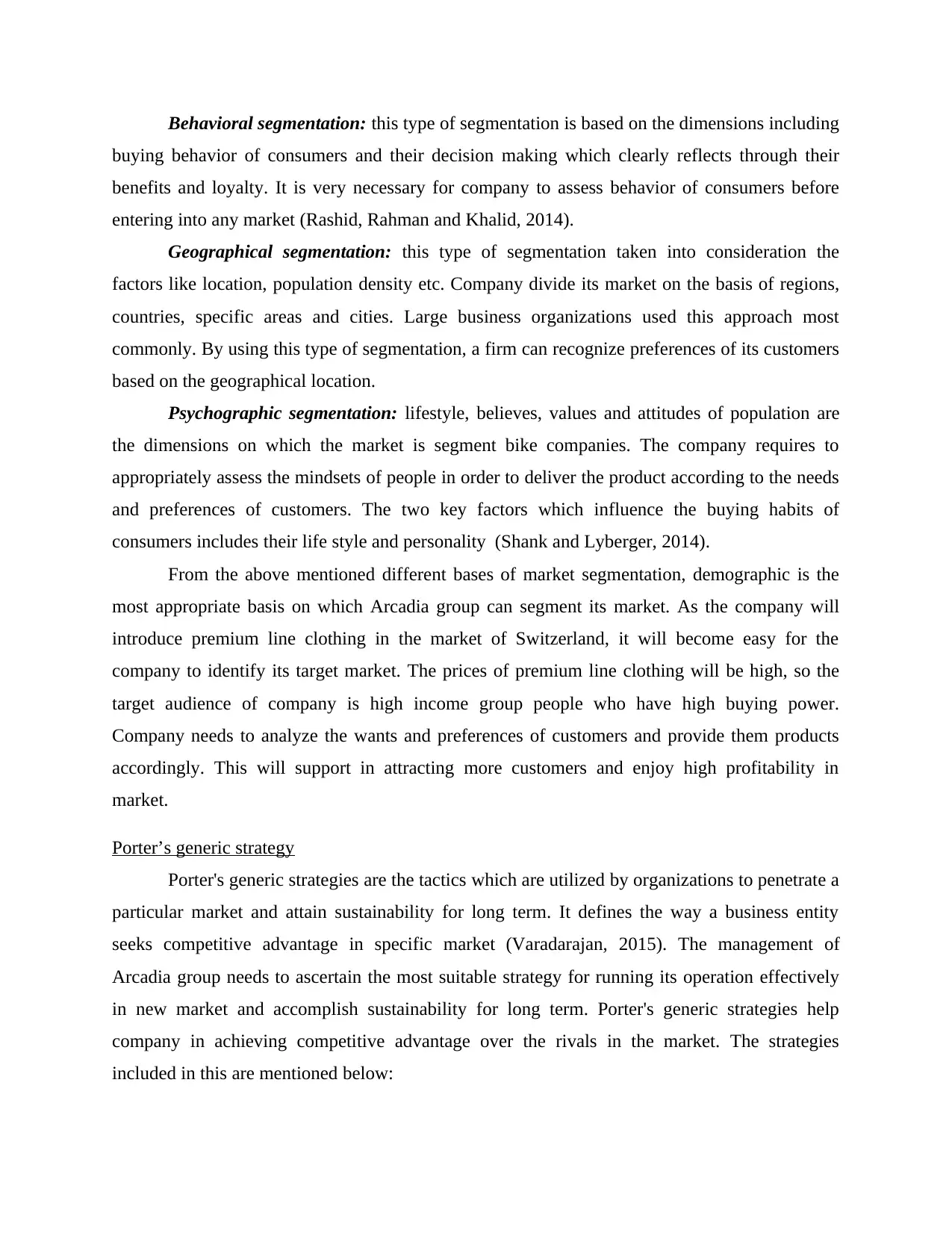
Behavioral segmentation: this type of segmentation is based on the dimensions including
buying behavior of consumers and their decision making which clearly reflects through their
benefits and loyalty. It is very necessary for company to assess behavior of consumers before
entering into any market (Rashid, Rahman and Khalid, 2014).
Geographical segmentation: this type of segmentation taken into consideration the
factors like location, population density etc. Company divide its market on the basis of regions,
countries, specific areas and cities. Large business organizations used this approach most
commonly. By using this type of segmentation, a firm can recognize preferences of its customers
based on the geographical location.
Psychographic segmentation: lifestyle, believes, values and attitudes of population are
the dimensions on which the market is segment bike companies. The company requires to
appropriately assess the mindsets of people in order to deliver the product according to the needs
and preferences of customers. The two key factors which influence the buying habits of
consumers includes their life style and personality (Shank and Lyberger, 2014).
From the above mentioned different bases of market segmentation, demographic is the
most appropriate basis on which Arcadia group can segment its market. As the company will
introduce premium line clothing in the market of Switzerland, it will become easy for the
company to identify its target market. The prices of premium line clothing will be high, so the
target audience of company is high income group people who have high buying power.
Company needs to analyze the wants and preferences of customers and provide them products
accordingly. This will support in attracting more customers and enjoy high profitability in
market.
Porter’s generic strategy
Porter's generic strategies are the tactics which are utilized by organizations to penetrate a
particular market and attain sustainability for long term. It defines the way a business entity
seeks competitive advantage in specific market (Varadarajan, 2015). The management of
Arcadia group needs to ascertain the most suitable strategy for running its operation effectively
in new market and accomplish sustainability for long term. Porter's generic strategies help
company in achieving competitive advantage over the rivals in the market. The strategies
included in this are mentioned below:
buying behavior of consumers and their decision making which clearly reflects through their
benefits and loyalty. It is very necessary for company to assess behavior of consumers before
entering into any market (Rashid, Rahman and Khalid, 2014).
Geographical segmentation: this type of segmentation taken into consideration the
factors like location, population density etc. Company divide its market on the basis of regions,
countries, specific areas and cities. Large business organizations used this approach most
commonly. By using this type of segmentation, a firm can recognize preferences of its customers
based on the geographical location.
Psychographic segmentation: lifestyle, believes, values and attitudes of population are
the dimensions on which the market is segment bike companies. The company requires to
appropriately assess the mindsets of people in order to deliver the product according to the needs
and preferences of customers. The two key factors which influence the buying habits of
consumers includes their life style and personality (Shank and Lyberger, 2014).
From the above mentioned different bases of market segmentation, demographic is the
most appropriate basis on which Arcadia group can segment its market. As the company will
introduce premium line clothing in the market of Switzerland, it will become easy for the
company to identify its target market. The prices of premium line clothing will be high, so the
target audience of company is high income group people who have high buying power.
Company needs to analyze the wants and preferences of customers and provide them products
accordingly. This will support in attracting more customers and enjoy high profitability in
market.
Porter’s generic strategy
Porter's generic strategies are the tactics which are utilized by organizations to penetrate a
particular market and attain sustainability for long term. It defines the way a business entity
seeks competitive advantage in specific market (Varadarajan, 2015). The management of
Arcadia group needs to ascertain the most suitable strategy for running its operation effectively
in new market and accomplish sustainability for long term. Porter's generic strategies help
company in achieving competitive advantage over the rivals in the market. The strategies
included in this are mentioned below:
⊘ This is a preview!⊘
Do you want full access?
Subscribe today to unlock all pages.

Trusted by 1+ million students worldwide
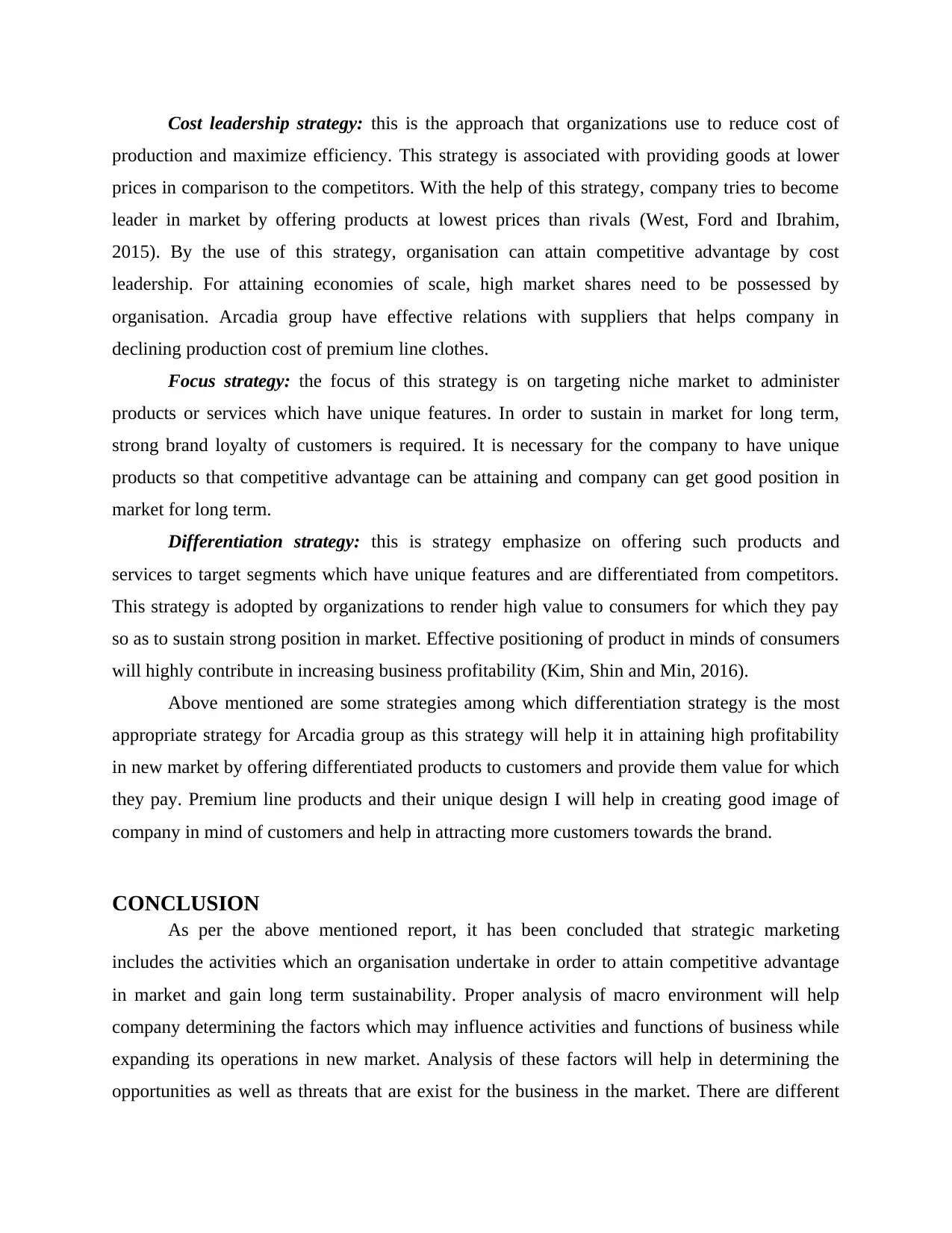
Cost leadership strategy: this is the approach that organizations use to reduce cost of
production and maximize efficiency. This strategy is associated with providing goods at lower
prices in comparison to the competitors. With the help of this strategy, company tries to become
leader in market by offering products at lowest prices than rivals (West, Ford and Ibrahim,
2015). By the use of this strategy, organisation can attain competitive advantage by cost
leadership. For attaining economies of scale, high market shares need to be possessed by
organisation. Arcadia group have effective relations with suppliers that helps company in
declining production cost of premium line clothes.
Focus strategy: the focus of this strategy is on targeting niche market to administer
products or services which have unique features. In order to sustain in market for long term,
strong brand loyalty of customers is required. It is necessary for the company to have unique
products so that competitive advantage can be attaining and company can get good position in
market for long term.
Differentiation strategy: this is strategy emphasize on offering such products and
services to target segments which have unique features and are differentiated from competitors.
This strategy is adopted by organizations to render high value to consumers for which they pay
so as to sustain strong position in market. Effective positioning of product in minds of consumers
will highly contribute in increasing business profitability (Kim, Shin and Min, 2016).
Above mentioned are some strategies among which differentiation strategy is the most
appropriate strategy for Arcadia group as this strategy will help it in attaining high profitability
in new market by offering differentiated products to customers and provide them value for which
they pay. Premium line products and their unique design I will help in creating good image of
company in mind of customers and help in attracting more customers towards the brand.
CONCLUSION
As per the above mentioned report, it has been concluded that strategic marketing
includes the activities which an organisation undertake in order to attain competitive advantage
in market and gain long term sustainability. Proper analysis of macro environment will help
company determining the factors which may influence activities and functions of business while
expanding its operations in new market. Analysis of these factors will help in determining the
opportunities as well as threats that are exist for the business in the market. There are different
production and maximize efficiency. This strategy is associated with providing goods at lower
prices in comparison to the competitors. With the help of this strategy, company tries to become
leader in market by offering products at lowest prices than rivals (West, Ford and Ibrahim,
2015). By the use of this strategy, organisation can attain competitive advantage by cost
leadership. For attaining economies of scale, high market shares need to be possessed by
organisation. Arcadia group have effective relations with suppliers that helps company in
declining production cost of premium line clothes.
Focus strategy: the focus of this strategy is on targeting niche market to administer
products or services which have unique features. In order to sustain in market for long term,
strong brand loyalty of customers is required. It is necessary for the company to have unique
products so that competitive advantage can be attaining and company can get good position in
market for long term.
Differentiation strategy: this is strategy emphasize on offering such products and
services to target segments which have unique features and are differentiated from competitors.
This strategy is adopted by organizations to render high value to consumers for which they pay
so as to sustain strong position in market. Effective positioning of product in minds of consumers
will highly contribute in increasing business profitability (Kim, Shin and Min, 2016).
Above mentioned are some strategies among which differentiation strategy is the most
appropriate strategy for Arcadia group as this strategy will help it in attaining high profitability
in new market by offering differentiated products to customers and provide them value for which
they pay. Premium line products and their unique design I will help in creating good image of
company in mind of customers and help in attracting more customers towards the brand.
CONCLUSION
As per the above mentioned report, it has been concluded that strategic marketing
includes the activities which an organisation undertake in order to attain competitive advantage
in market and gain long term sustainability. Proper analysis of macro environment will help
company determining the factors which may influence activities and functions of business while
expanding its operations in new market. Analysis of these factors will help in determining the
opportunities as well as threats that are exist for the business in the market. There are different
Paraphrase This Document
Need a fresh take? Get an instant paraphrase of this document with our AI Paraphraser
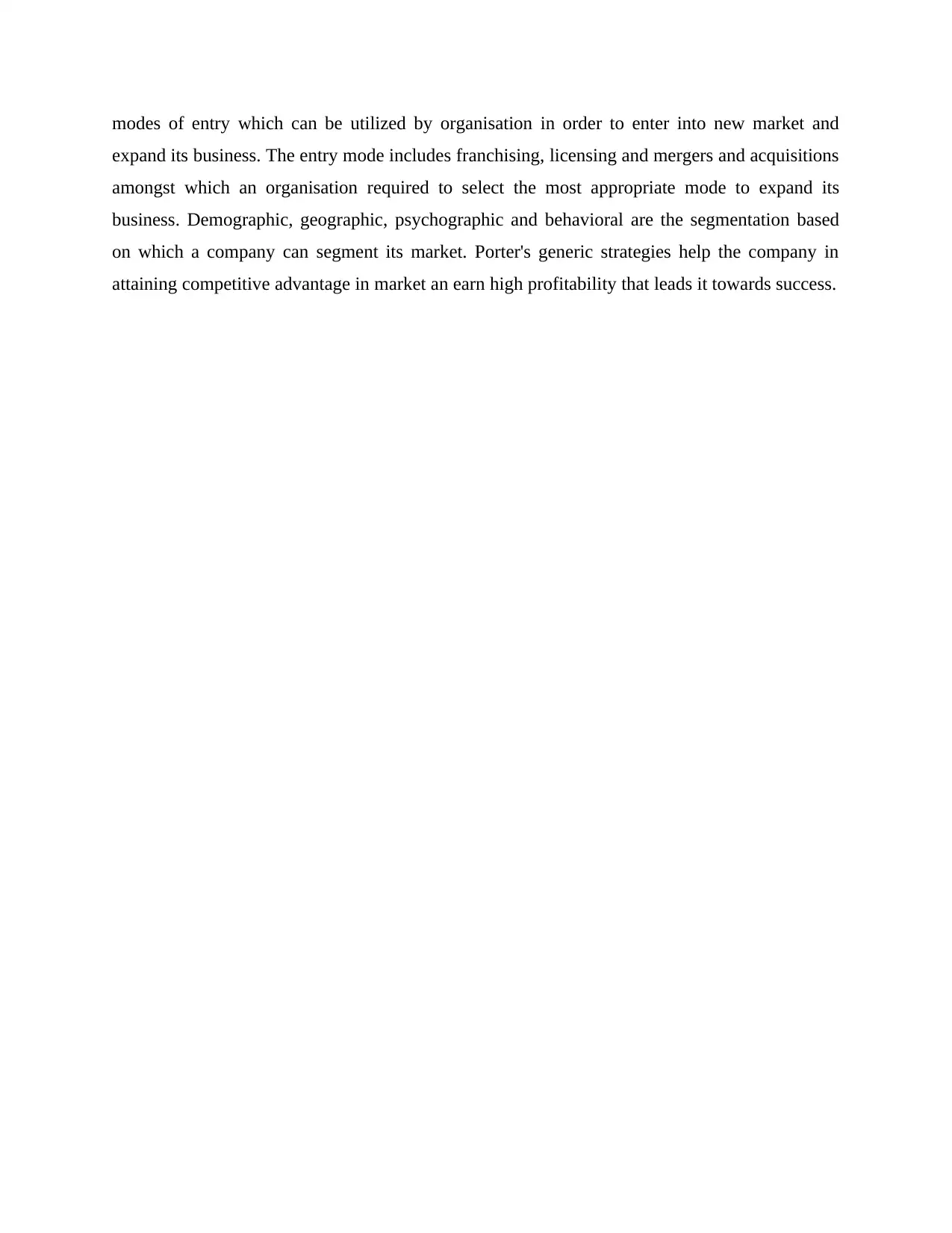
modes of entry which can be utilized by organisation in order to enter into new market and
expand its business. The entry mode includes franchising, licensing and mergers and acquisitions
amongst which an organisation required to select the most appropriate mode to expand its
business. Demographic, geographic, psychographic and behavioral are the segmentation based
on which a company can segment its market. Porter's generic strategies help the company in
attaining competitive advantage in market an earn high profitability that leads it towards success.
expand its business. The entry mode includes franchising, licensing and mergers and acquisitions
amongst which an organisation required to select the most appropriate mode to expand its
business. Demographic, geographic, psychographic and behavioral are the segmentation based
on which a company can segment its market. Porter's generic strategies help the company in
attaining competitive advantage in market an earn high profitability that leads it towards success.
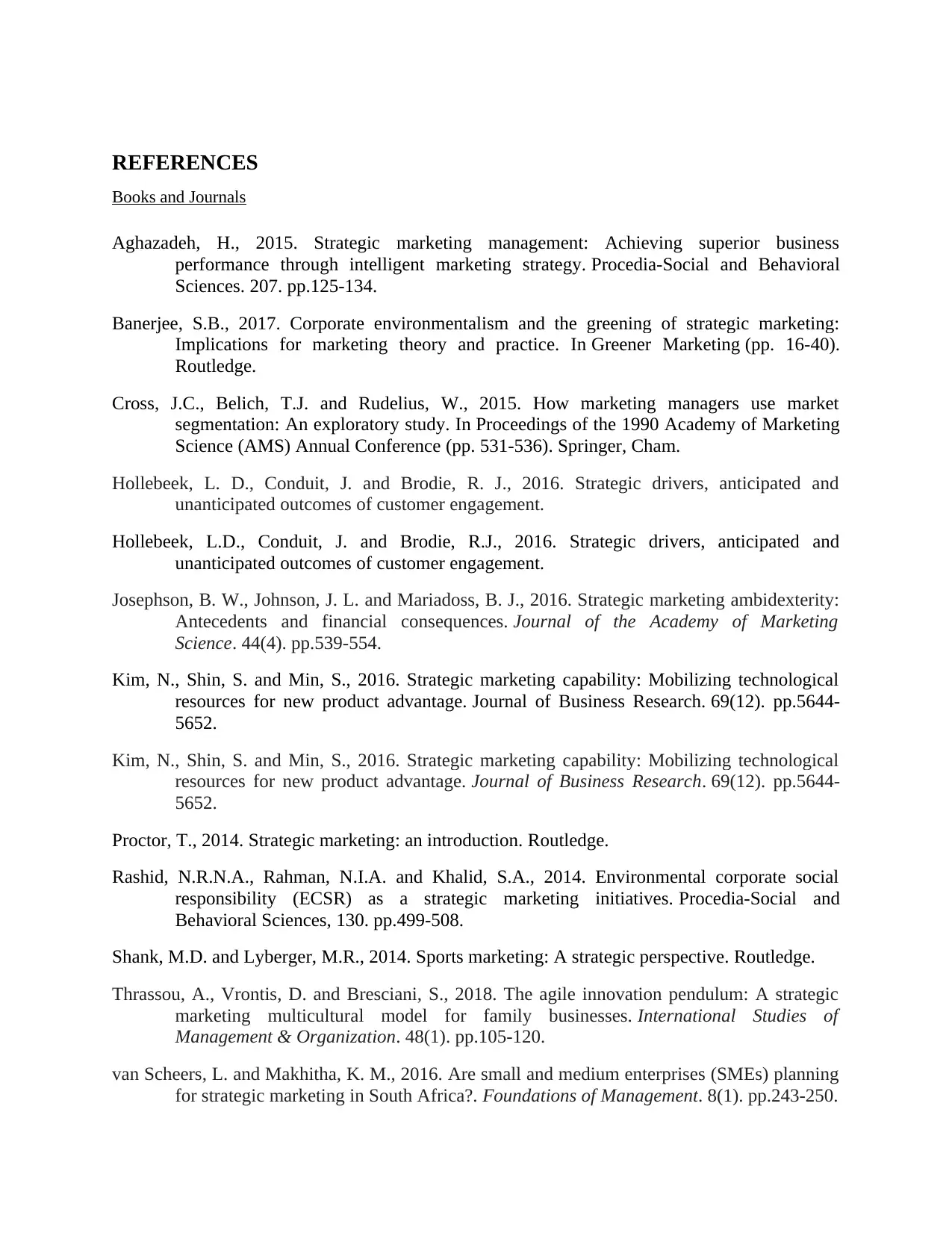
REFERENCES
Books and Journals
Aghazadeh, H., 2015. Strategic marketing management: Achieving superior business
performance through intelligent marketing strategy. Procedia-Social and Behavioral
Sciences. 207. pp.125-134.
Banerjee, S.B., 2017. Corporate environmentalism and the greening of strategic marketing:
Implications for marketing theory and practice. In Greener Marketing (pp. 16-40).
Routledge.
Cross, J.C., Belich, T.J. and Rudelius, W., 2015. How marketing managers use market
segmentation: An exploratory study. In Proceedings of the 1990 Academy of Marketing
Science (AMS) Annual Conference (pp. 531-536). Springer, Cham.
Hollebeek, L. D., Conduit, J. and Brodie, R. J., 2016. Strategic drivers, anticipated and
unanticipated outcomes of customer engagement.
Hollebeek, L.D., Conduit, J. and Brodie, R.J., 2016. Strategic drivers, anticipated and
unanticipated outcomes of customer engagement.
Josephson, B. W., Johnson, J. L. and Mariadoss, B. J., 2016. Strategic marketing ambidexterity:
Antecedents and financial consequences. Journal of the Academy of Marketing
Science. 44(4). pp.539-554.
Kim, N., Shin, S. and Min, S., 2016. Strategic marketing capability: Mobilizing technological
resources for new product advantage. Journal of Business Research. 69(12). pp.5644-
5652.
Kim, N., Shin, S. and Min, S., 2016. Strategic marketing capability: Mobilizing technological
resources for new product advantage. Journal of Business Research. 69(12). pp.5644-
5652.
Proctor, T., 2014. Strategic marketing: an introduction. Routledge.
Rashid, N.R.N.A., Rahman, N.I.A. and Khalid, S.A., 2014. Environmental corporate social
responsibility (ECSR) as a strategic marketing initiatives. Procedia-Social and
Behavioral Sciences, 130. pp.499-508.
Shank, M.D. and Lyberger, M.R., 2014. Sports marketing: A strategic perspective. Routledge.
Thrassou, A., Vrontis, D. and Bresciani, S., 2018. The agile innovation pendulum: A strategic
marketing multicultural model for family businesses. International Studies of
Management & Organization. 48(1). pp.105-120.
van Scheers, L. and Makhitha, K. M., 2016. Are small and medium enterprises (SMEs) planning
for strategic marketing in South Africa?. Foundations of Management. 8(1). pp.243-250.
Books and Journals
Aghazadeh, H., 2015. Strategic marketing management: Achieving superior business
performance through intelligent marketing strategy. Procedia-Social and Behavioral
Sciences. 207. pp.125-134.
Banerjee, S.B., 2017. Corporate environmentalism and the greening of strategic marketing:
Implications for marketing theory and practice. In Greener Marketing (pp. 16-40).
Routledge.
Cross, J.C., Belich, T.J. and Rudelius, W., 2015. How marketing managers use market
segmentation: An exploratory study. In Proceedings of the 1990 Academy of Marketing
Science (AMS) Annual Conference (pp. 531-536). Springer, Cham.
Hollebeek, L. D., Conduit, J. and Brodie, R. J., 2016. Strategic drivers, anticipated and
unanticipated outcomes of customer engagement.
Hollebeek, L.D., Conduit, J. and Brodie, R.J., 2016. Strategic drivers, anticipated and
unanticipated outcomes of customer engagement.
Josephson, B. W., Johnson, J. L. and Mariadoss, B. J., 2016. Strategic marketing ambidexterity:
Antecedents and financial consequences. Journal of the Academy of Marketing
Science. 44(4). pp.539-554.
Kim, N., Shin, S. and Min, S., 2016. Strategic marketing capability: Mobilizing technological
resources for new product advantage. Journal of Business Research. 69(12). pp.5644-
5652.
Kim, N., Shin, S. and Min, S., 2016. Strategic marketing capability: Mobilizing technological
resources for new product advantage. Journal of Business Research. 69(12). pp.5644-
5652.
Proctor, T., 2014. Strategic marketing: an introduction. Routledge.
Rashid, N.R.N.A., Rahman, N.I.A. and Khalid, S.A., 2014. Environmental corporate social
responsibility (ECSR) as a strategic marketing initiatives. Procedia-Social and
Behavioral Sciences, 130. pp.499-508.
Shank, M.D. and Lyberger, M.R., 2014. Sports marketing: A strategic perspective. Routledge.
Thrassou, A., Vrontis, D. and Bresciani, S., 2018. The agile innovation pendulum: A strategic
marketing multicultural model for family businesses. International Studies of
Management & Organization. 48(1). pp.105-120.
van Scheers, L. and Makhitha, K. M., 2016. Are small and medium enterprises (SMEs) planning
for strategic marketing in South Africa?. Foundations of Management. 8(1). pp.243-250.
⊘ This is a preview!⊘
Do you want full access?
Subscribe today to unlock all pages.

Trusted by 1+ million students worldwide
1 out of 13
Related Documents
Your All-in-One AI-Powered Toolkit for Academic Success.
+13062052269
info@desklib.com
Available 24*7 on WhatsApp / Email
![[object Object]](/_next/static/media/star-bottom.7253800d.svg)
Unlock your academic potential
Copyright © 2020–2025 A2Z Services. All Rights Reserved. Developed and managed by ZUCOL.





